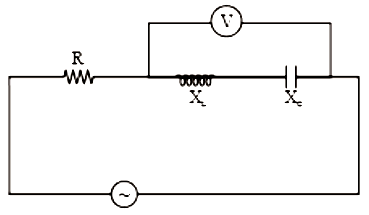The phase difference between the current and voltage of LCR circuit in series combination at resonance is
1. 0
2. π/2
3. π
4. –π
In a series resonant circuit, the ac voltage across resistance R, inductance L and capacitance C are 5 V, 10 V and 10 V respectively. The ac voltage applied to the circuit will be
1. 20 V
2. 10 V
3. 5 V
4. 25 V
A transistor-oscillator using a resonant circuit with an inductance \(L\) (of negligible resistance) and a capacitance \(C\) has a frequency \(f.\) If \(L\) is doubled and \(C\) is changed to \(4C,\) the frequency will be:
1. \(f/4\)
2. \(8f\)
3. \(f/2\sqrt2\)
4. \(f/2\)
In the LCR-circuit shown below, if the reading of the voltmeters and are same, then
1.
2. Reading of the voltmeter V is 50 V
3. Reading of the ammeter A is 5 A
4. All of these
In LC oscillation, what is the current in the circuit when the total energy is stored in the form of magnetic energy?
(q0 is the maximum charge stored by the capacitor)
The ratio of resonant angular frequency and bandwidth of a given series LCR circuit is-
1. Inversely proportional to the angular frequency of ac
2. Directly proportional to the angular frequency of ac
3. Independent of the angular frequency of ac
4. Directly proportional to the square of the angular frequency of a.c
Current l through an inductor is increasing according to . Variation of the rate of increment of its energy with time t is correctly shown in the graph
1. 
3. 
For the circuit shown in figure below, the ammeter reads 1.6 A and ammeter read 0.4 A If is angular frequency and is frequency of ac, then
What is the value of the power factor for a parallel LC circuit at a frequency less than the resonance frequency?
1. Zero
2. 1
3. > 1
4.< 1












